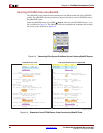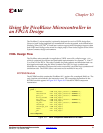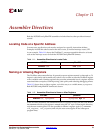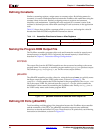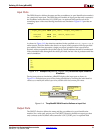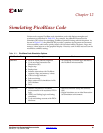
PicoBlaze 8-bit Embedded Microcontroller www.xilinx.com 75
UG129 (v1.1.2) June 24, 2008
R
Chapter 11
Assembler Directives
Both the KCPSM3 and pBlazIDE assemblers include directives that provide advanced
control.
Locating Code at a Specific Address
In some cases, application code must be assigned to a specific instruction address.
Examples include the code located at the reset vector, 0, and the interrupt vector, 3FF.
As an example, Table 11-1 shows the PicoBlaze™ processor assembler directive to locate
code at the interrupt vector for both the KCPSM3 and pBlazIDE formats.
Naming or Aliasing Registers
The PicoBlaze microcontroller has 16 general-purpose registers named s0 through sF. To
improve code clarity and to enable easy code re-use, re-name or alias the PicoBlaze register
with a variable name. Naming registers also prevents unintended use of a register and the
associated data corruption, both improving code quality and reducing debugging efforts.
Table 11-2 shows how to alias a register, s5 in this case, to a variable name, myregname.
Both KCPSM3 and pBlazIDE formats are shown.
In the KCPSM3 assembler, the NAMEREG directive is applied in-line with the code. Before
the NAMEREG directive, the register is named using the ‘sX’ style. Following the directive,
only the new name applies. It is also possible to rename a register again (i.e., NAMEREG
old_regname, new_regname) and only the new name applies in the subsequent
program lines.
Table 11-1: Assembler Directives to Locate Code
KCPSM3 pBlazIDE
ADDRESS 3FF ORG $3FF
Table 11-2: Assembler Directives to Name or Alias Registers
KCPSM3 pBlazIDE
NAMEREG s5, myregname myregname EQU s5




